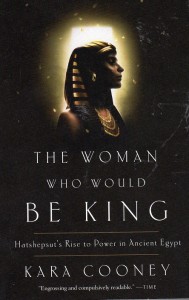Book Review: The Woman Who Would Be King: Hatshepsut’s Rise to Power in Ancient Egypt by Kara Cooney
Hatshepsut lived about 1500 B.C.E. to circa 1458 B.C.E. The daughter of Thutmose I, she was married to Thutmose II, her half-brother, when he ascended the throne of Egypt. As the God’s Wife of Amen-Re (king of all the Egyptian gods) and King’s Great Wife (like many kings of the period, Thutmose II had several wives, of which she was the most important), Hatshepsut helped run the country. But Thutmose II was sickly, and died young. Hatshepsut had only produced a daughter, and Thutmose III, her nephew and the crown prince, was only a toddler.
Hatshepsut was made regent for the infant king, and seems to have done a good job. But she realized it would be many years before he was ready to rule, even if he lived, and the Egyptians did not at that time have a word for “queen.” To keep the country stable, Hatshepsut had to become king. Even if that meant transforming her public identity to match the masculine image the job seemed to require.
Kara Cooney is an Egyptologist and associate professor at UCLA who has done extensive research on the subject of Hatshepsut, with the result being this book. According to this volume, early Egyptologists took the destruction of many of Hatshepsut’s statues and the erasure of her name to indicate that she was an usurper who abused her power, fitting a narrative that women are unfit to rule. But more recent research has shown that the erasure mostly took place a good quarter-century after her death, towards the end of Thutmose III’s reign.
Professor Cooney attempts to build a narrative of Hatshepsut’s life; this is difficult because the ancient Egyptians had a strong tendency not to mention anything personal or negative about their rulers; even regicide was only referred to obliquely. Plus, of course, most of the records vanishing after a couple of thousand years. What does seem to emerge from the available information is that Hatshepsut was a competent ruler, faithful to her gods, and adding to the prosperity of her kingdom with many building programs.
She seems to have tried as hard as possible to adapt to the role of king, rather than trying to make the role of king fit her, as seen by her statues slowly taking on more masculine attributes.
Mind, by modern standards, the conquering and enslaving of neighboring countries would be considered a negative character trait.
If there were any difficulties between her and Thutmose III, her co-king, they did not enter the records. What seems to have prompted her later erasure was that Thutmose III wanted to ensure that the male line of succession was maintained, so rewrote history to make it seem that he had become king immediately after his father with no woman at the helm.
Her chief steward, Senemut, on the other hand, seems to have fallen from grace immediately after Hatshepsut’s death. The remaining traces of him suggest that he was one of those people who boasts in public about how tight he is with the king, and once she was gone, his enemies made their displeasure known.
There’s a lot of “might” and “maybe” and “probably” in the text here, and the extensive footnotes cover alternative interpretations of the evidence. This makes the narrative rather dry, and best suited to college-level readers. There is a chronology of the Eighteenth through Twentieth Dynasties, an (incomplete) family tree of Hatshupset, a center section of black and white photos, a bibliography and index.
One interesting tidbit from the notes: apparently, the word that would become “Pharaoh” came into use about this time to mean “the person in the palace” for those who didn’t want to use the male “king” for Hatshupset.
This book is recommended to scholars interested in ancient Egypt, and people who want to read about another woman who ruled Egypt besides Cleopatra.
Disclaimer: I received a free copy of this volume from Blogging for Books for the purpose of this review. No other compensation is involved or requested.


I do love reading about ancient Egypt, so this one will be making into my reading pile. What an interesting line into power. Feminist attitudes certainly have a long history of counter attitudes to overcome. 🙂
One of the threads the writer comes back to often is how careful Hatshepsut was to clarify that she was acting in accordance with the will of the gods and the traditions of Egypt, even while she was taking unprecedented steps.
This sounds like a very interesting story. I’m sure it is difficult to recount details and info from so long ago.
Thus all the “mights” an d “maybes”.
Well, how cool was she? So bold, brave and strong. I have to say, I actually enjoyed reading your summary. I’m not generally one to enjoy history but this really fascinated me. Thanks Scott!
A good history book should be able to be summarized effectively. Especially (if like this one) it is going to be used for college classes.